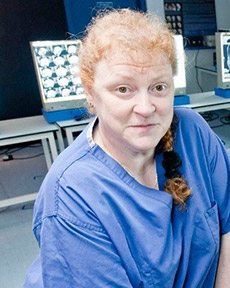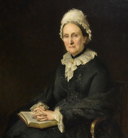
-
Celebrations begin to commemorate 50 years of the University of Dundee
2017 -
The University of Dundee becomes a fully independent institution under the terms of the Royal Charter.
1967 -
Ordinances issued in 1897 made University College form part of St Andrews. and establish a Faculty of Medicine.
1897 -
The Deed formally creating University College Dundee was signed by founders Miss Mary Ann Baxter and her cousin Dr John Boyd Baxter.
1881
Hospitals
-
date
Fri, 22 Sep 2017
-
Running Time
00:06:37
Graduation day is the culmination of a student's time at university.
Episode Transcript
I'm Sue Black and welcome to the University of Dundee and our weekly look at the moments in history - both of the institution and the city - that have created the vibrant, dynamic place that we’re now part of.
As we celebrate the 50th anniversary of the University becoming independent, we examine the people, discoveries and decisions that have brought us to 2017 as Scotland’s University of the Year and one of the world's Top 200 universities, helping to transform lives across society. As an industrial town with more than its fair share of health-related problems, Dundee has long placed heavy demands on its hospitals, and over the years the city’s doctors, surgeons and nurses have worked tirelessly to treat sickness and disease and to help with the birth of generations of Dundonians.
It is no surprise, then, that Dundee's hospitals have such a strong place in the affections of its people. Although there had been hospital buildings in Dundee since at least the 14th century, the town’s first modern infirmary opened in King Street in 1798. However the rapid expansion of the town over the next 50 years into a heavily industrialised centre for jute production led to a massive increase in the population, with many living and working in terrible conditions.
This made it necessary for a new and much larger hospital to be built, and the new Dundee Royal Infirmary (known as DRI) opened on Constitution Road in 1855. It would go on to serve the city until 1998, exactly 200 years after the original Infirmary had opened. Other hospitals followed for different specialisms, including Kings Cross Hospital for fever patients, the Lunatic Asylum at West Green, the Eastern Hospital attached to the poorhouse and the Baldovan Institute (later renamed Strathmartine), Scotland’s first residential hospital for children with learning disabilities, and only the second in Britain.
The Royal Victoria Hospital at Balgay opened for 'incurables' in 1897. Nine years later it was expanded to create a new wing for cancer patients, and the same year a new cancer research building was added at DRI, a reminder that Dundee’s reputation as a leading centre for the study of cancer, now led by the University of Dundee, dates back much further than is often assumed. By that time, most medical research in Dundee was concentrated in the city’s new medical school at University College, with DRI offering its services as a teaching hospital.
However it was only with the building of Ninewells Hospital six decades later that medical teaching and clinical practice were fully integrated in one place. Ninewells was the first completely new UK teaching hospital to be built in the 20th century, and most aspects of policy and design had to be considered from scratch. A £50,000 programme of full scale mock-ups allowed for the testing of certain key areas of layout, equipment and component design in the wards, laboratories and operating theatres. With the rapid and uncertain growth of medical science, few of the diagnostic and research laboratories were made for a specific purpose.
The new, flexible design allowed these to be placed together either as single or grouped larger laboratories. A new concept was developed at Ninewells of a low group of buildings to facilitate ease of movement, face-to-face contact and future expansion. The slope of the site was used to separate people inside the building, each level having its distinct point of access on the north side. The wards were located on the quiet south and west aspects to minimise noise and maximise light. The ward unit was designed to give patients a degree of seclusion, in particular to minimise ward traffic for the most seriously ill patients.
A key feature of Ninewells was the 'embedding' of the Medical School in the hospital. The planning of nearly every unit was influenced by the need for students to see, hear and test their knowledge in a clinical situation. The traditional ‘teaching round’ was not to be encouraged and each ward was allocated two separate rooms for teaching purposes. Out-patient clinics were planned to allow for two or three students attending each clinic. 25 years after its initial approval was granted, Ninewells Hospital opened in 1974 with justifiable pride. Indeed, the project was such a major scheme that it attracted visits from all over the world, and the feature which always most impressed visitors was the ‘embedding’ of the medical school in the hospital.
A visit from the International Hospital Federation to major facilities in Scotland led to Ninewells being described as the 'Jewel in the Scottish Hospital Crown'. The University of Dundee is still a vital part of Ninewells today, driving forward technological innovations in treatment such as new instruments and techniques in laparoscopic surgery, as well as its world-leading research into the treatment and understanding of cancer and diabetes and new areas such as medical genetics and robotic surgery. Fascinating objects from many of Dundee’s hospitals past and present can now be seen in the Tayside Medical History Museum at Ninewells, open to the public daily.
Sue Black

Professor Sue Black was born in Inverness and educated at Inverness Royal Academy.In 1982 she was awarded a Bachelor of Science with Honours in human anatomy from the University of
Aberdeen. She later went on to earn her Doctor of Philosophy in human anatomy for her thesis on'Identification from the human skeleton', also from the University of Aberdeen.
In 1987, she took up the post of lecturer in Anatomy at St Thomas' Hospital, London, starting her careerin forensic anthropology, she served in this role until 1992.
Between 1992 and 2003 she undertook various contract work for the United Kingdom's Foreign andCommonwealth Office and the United Nations, involving the identification of victims and perpetrators ofvarious conflicts.
In 1999, she became the lead forensic anthropologist to the British Forensic Team in Kosovo, deployedby the Foreign and Commonwealth Office on behalf of the United Nations.
In 2003 she undertook two tours to Iraq and in 2005 she participated in the United Kingdom'scontribution to the Thai Tsunami Victim Identification operation, as part of the 2004 Indian Oceanearthquake and tsunami international response.
In 2003, Black was appointed Professor of Anatomy and Forensic Anthropology at the University ofDundee. In 2008, she was appointed as head of the newly created Centre for Anatomy & HumanIdentification at the University of Dundee (CAHID).
Professor Black is past President of the British Association of Human Identification (BAHID), and thecurrent President of Association for Science Education (Scotland).
-
Celebrations begin to commemorate 50 years of the University of Dundee
2017 -
The University of Dundee becomes a fully independent institution under the terms of the Royal Charter.
 1967
1967 -
Ordinances issued in 1897 made University College form part of St Andrews. and establish a Faculty of Medicine.
1897 -
The Deed formally creating University College Dundee was signed by founders Miss Mary Ann Baxter and her cousin Dr John Boyd Baxter.
 1881
1881